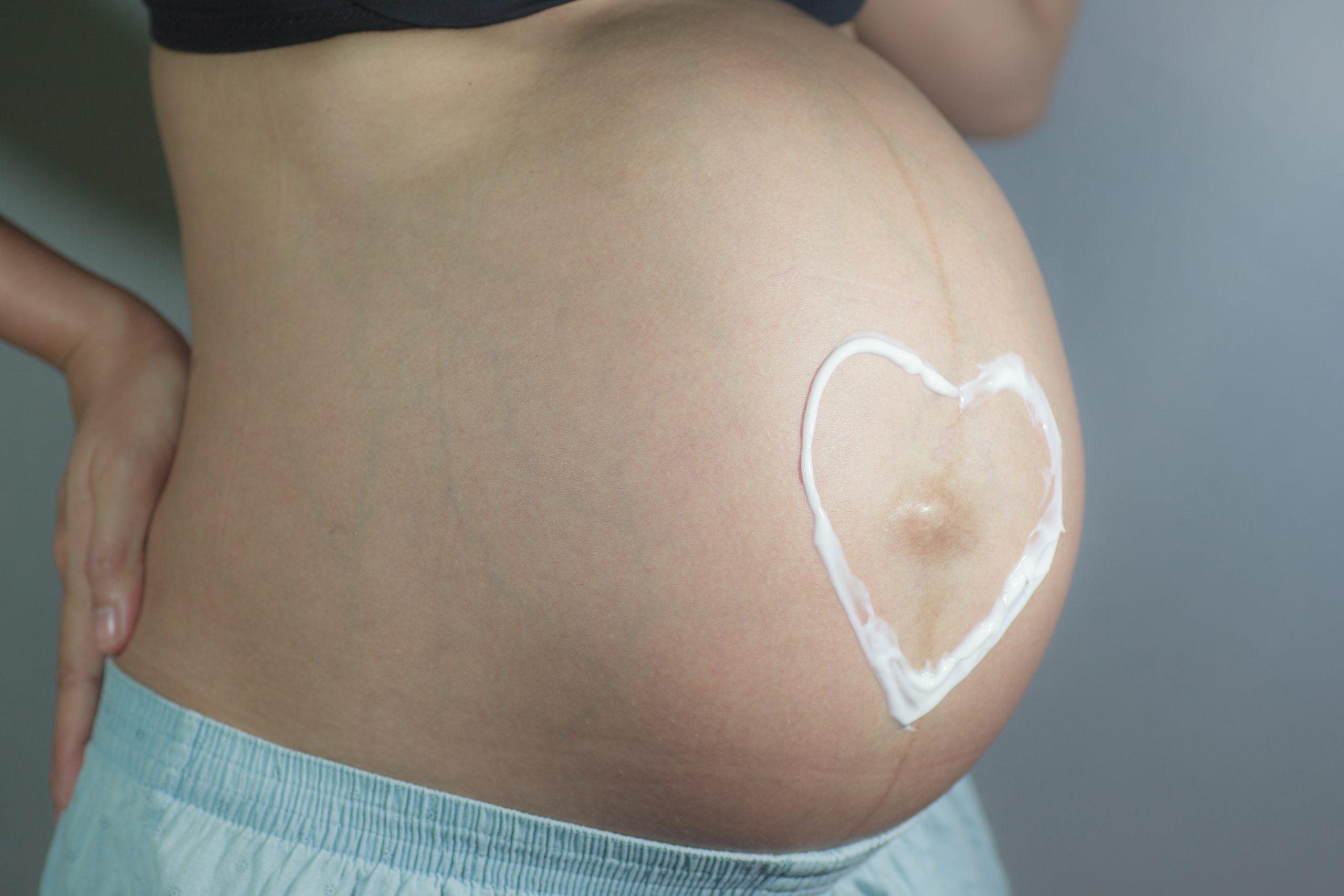Our bodies are capable of adapting to many massive changes, which does not mean each change won’t leave a mark. Stretch marks are a phenomenon that is common and extremely normal, especially among pregnant women. For some they are just as casual as another event, for some it is a cause of distress. But just like everything, we have every right to know their underlying causes. What causes us to have those streaks in our bodies? Can we get rid of them? Do we need to get rid of them? How do we get rid of them? Many questions come to mind at the sight of those colourful streaks. Together, let’s explore each one of them and more.
What Are Stretch Marks?
Stretch marks also known as striae gravidarum, are streaks or bands that develop on the skin during pregnancy, or any other abrupt physical change our bodies go through. They tend to form when your skin expands or shrinks rapidly. Itchy, thin and pink at the start, the marks tend to get long, and pink, red or brown in colour. They typically appear around the breasts, abdomen, buttocks and thighs. While these are their most common traits, their appearance can differ from one individual to the next.
When we say that almost every woman experiences stretch marks when pregnant, we are not exaggerating. Roughly 90% of women form stretch marks in their bodies when pregnant. Research suggests that women with a higher abdominal circumference, higher body mass before pregnancy and greater weight gain are particularly susceptible. Your genes and age can also be a contributing factor.
What Causes Stretch Marks?
Many factors contribute to stretch mark formation on your body from your family history to your physical traits. Causes are a bottomless ocean, but we have prepared a list of the most common causes of stretch marks for you. Let’s explore:
- Rapid weight gain: As the most common cause of stretch marks during pregnancy, rapid weight gain takes the prize. Sudden expansion of the skin and weight fluctuations can abruptly happen during pregnancy, especially during the second trimester and affect the skin around the breasts, thighs, abdomen and buttocks as it does not have adequate time to adjust.
- Genetic factors: Some individuals are genetically more inclined to develop stretch marks. If your mother, or sister have experienced them during pregnancy, it is highly possible that you will develop them as well.
- Hormonal changes: Hormonal fluctuations during pregnancy can affect the elasticity and structure of your skin, making you more susceptible to stretch marks.
- Changes in your cortisone levels: When cortisone levels increase in your body, it becomes a hormone that weakens the skin’s elasticity. Cortisone levels rise during pregnancy which is another issue that can contribute to the development of stretch marks.
- Carrying multiple babies: Carrying more than one baby, and having double or more the amount of responsibility in your body, can put more pressure on your skin, causing you to develop stretch marks.
- Your age: If you are a younger expecting woman, your chances of getting stretch marks are a bit higher than the women who get pregnant older. If you are in your early 20s or younger than that, since your skin is still open to development, you are more open to stretch marks. Women older than 35 also have a high chance of getting stretch marks when pregnant, since their skin has gradually aged till now.
Are Stretch Marks Dangerous?
No! They might be a symptom of a few specific medical conditions, but they are not threatening or harmful, and do not cause any known medical problems.
Do Stretch Marks Fade After Pregnancy?
Since it is a form of skin scarring, stretch marks may not completely fade on their own. However, while they tend to be very apparent in the final trimester, they can slowly begin to fade after you get to hold your baby in your arms. They might even start to turn a bit lighter in colour on their own.
How to Prevent Stretch Marks
Stretch marks are caused by abrupt physical changes, so sometimes preventing them can be a hassle. But by taking certain precautions, we might be able to lessen the effects on your body and ease yourself a bit during a chaotic time in your life if, though we hope it is not, stretch marks are a cause of stress for you. Here is a small but extensive list of things we can do to prevent stretch marks:
- Natural topical creams: Applying specially formulated creams containing ingredients like shea butter, hyaluronic acid, and aloe vera could prevent the formation of stretch marks. Using them daily starting around the third month of your pregnancy, can help with maintaining your skin’s elasticity, drastically decreasing the sight of stretch marks.
- Hydration: Hydration is essential during pregnancy to keep up with the increased blood volume in your body and help build the water sack for your baby. Keeping yourself hydrated also contributes to the elasticity, making it less prone to the damage caused by the stretch.
- Balanced diet: Maintaining a healthy, well-balanced diet and not skipping foods rich in collagen and gelatine can help you maintain your weight at a steady rate and help your skin stay elastic, keeping up with your bodily changes.
- Increasing your vitamin C intake: Vitamin C-rich foods and vegetables contain antioxidants that help repair skin and tissue damage, which helps maintain your skin’s elasticity and prevent stretch marks. When preparing your meals, try to incorporate vitamin C-rich foods like oranges, tomatoes, broccoli, cauliflower, spinach and other leafy greens into it.
- Massaging your skin: Gently massaging the areas where pregnancy stretch marks are likely to pop up like the abdomen, breasts, thighs, and buttocks with anti-stretch mark creams can also be highly beneficial to your skin’s elasticity, helping you prevent stretch marks.
- Light exercise: Staying active during pregnancy helps you avoid huge fluctuations in your body weight, helping your skin keep up with the changes in your body. Regular exercise helps boost circulation and blood flow to your skin, making it less vulnerable to any possible damage, thus stretch marks are less likely to happen.
How To Treat Stretch Marks
Your stretch marks are a badge of your journey of bringing a life into this world, and trust us when we say you are just as beautiful with or without them. Even so, if you want to get rid of them for many reasons, it is an option. They might be a hassle to prevent, or almost impossible to get rid of, but there are many ways that serve as a remedy, reducing their effects to as little as possible. While exploring our list below, keep in mind that some of these methods should be practised after pregnancy, not while breastfeeding, and not without getting approval from your doctor. Here is our extensive list for treating stretch marks, created just for you:
- Anti-stretch-mark creams and lotions: There are various creams to help reduce the appearance of stretch marks. When shopping, look for products containing ingredients such as shea butter, cocoa butter, vitamin E, avocado oil, hyaluronic acid, and vitamin C which may help improve collagen production and maintain skin elasticity.
- Laser therapy: Laser treatments on stretch marks can stimulate collagen production and improve their appearance. This is a non-invasive procedure which is done by using laser beams to target the affected areas and promote skin generation. Procedures like this may require multiple sessions for best results.
- Microdermabrasion: This procedure is done by exfoliating the outer layer of the skin to promote the growth of new and healthier skin cells. This procedure can help reduce the appearance of stretch marks.
- Chemical peels: This procedure is done by applying a chemical solution to the skin, causing the outer layer to peel off, which stimulates skin generation and can improve the appearance of stretch marks.




